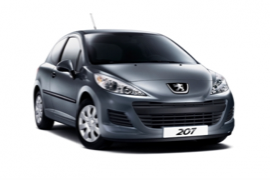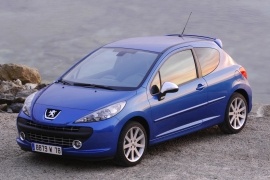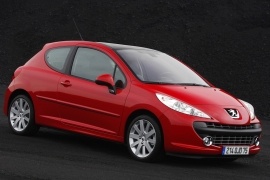PEUGEOT 207 3 Doors Models/Series Timeline, Specifications & Photos
First production year: 2006
Engines: Gasoline, Diesel
Body style: Hatchback
The French automaker Peugeot refreshed its small-sized vehicle lineup 307 in 2009 and made it fit into the Euro 5 emission standards, which became mandatory in September of that year.
Just three years have passed since the launch of the 207 lineup, but the B-segment Peugeot went through a necessary upgrade. Along with the technical bits and pieces that needed to be improved, the automaker also worked on the vehicle’s exterior and interior. In Europe, the small segment was highly contested, and almost all brands had something to offer there.
By 2009, Peugeot sold almost 1.5 million units of this vehicle, so it was an important vehicle in the automaker’s range. Still, it needed something more to make customers happy, especially teenagers who needed a vehicle for driving around town at an affordable price and in a sporty-looking vehicle. That was one of the reasons why the car manufacturer offered a three-door bodywork version for it.
At the front, the automaker created a new lower bumper that offered a sportier look for the vehicle by adding a set of side scoops that flanked the grille. As an option, customers could have fog lamps there. From its profile, the blackened B-posts created the impression of longer doors, even though they kept the same dimension as before. But the most significant difference was noticed at the back.
With the 2009 207, Peugeot introduced LED taillights on this successful model. This improvement was highly appreciated by customers, who saw it as an upgrade towards upscale brands. To further emphasize a premium look, buyers could order the vehicle with more chromed details on the exterior, around the windows, and the front fog lamps.
But Peugeot also knew that customers had to feel great inside the 207, so it enhanced the cabin with better and softer materials in most areas. As a result, it improved the perceived quality. Furthermore, the instrument cluster was slightly redesigned, with better-looking chromed surroundings. In terms of equipment, the automaker added Bluetooth connectivity for phone calls to the vehicle, which was offered as an option.
Among other new features, the car finally got a one-touch power window for the driver, but still, the rear ones were manual since they had a pop-out system. The AC got an auto function as an option, and base models came with a regular ventilation system and heating.
Peugeot installed either regular bucket seats or high-bolstered ones, depending on the engine version. Most versions came fitted with height adjustments for the driver’s position and tilt-column steering wheel. In the back, the split-folding (60/40) bench seat could expand the trunk space.
Under the hood, the automaker installed a choice of gasoline and turbodiesel engines ranging between 70 PS (69 hp) and 156 PS (154 hp) paired with five- or six-speed manual transmissions that sent their power to the front wheels. A six-speed automatic was available for specific versions.
Walking in the footsteps of the glorious Peugeot 205 GTI from the '80s, the 2007 Peugeot 207 RC was on the market for small-sized hot-hatches with performances and handling that thrilled the new generation of motorists in Europe.
Winding roads, twisty streets, and narrow parking spots are common in Europe. For those who want to enjoy both scenarios of mountain roads and daily driving situations, Peugeot brought back a former model and translated it into a new car: the 207 RC.
The 207 was launched in 2007 and boasts the RC initials to resemble the compact-coupe vehicle RCZ, which was compared with Audi TT. The 207 RC was slightly longer than 4 meters (157.5”) due to the FIA regulations regarding the rally races. The RC was made to be a base-car for further evolution into the rally-racing, to follow the glorious racing past achieved by its predecessors such as the 206WRC, 307WRC and the 205. The feline-style headlights were part of the brand image. An aggressive stance with a sporty front apron and a rear roof-spoiler enhanced the dynamic line of the car.
Inside, the sport bucket seats for the front passengers were complemented by contrast stitching. The instrument cluster was similar to those usually found on a motorbike, with circular chrome-trimmed dials, checked graphics, rounded typography, and red needles.
From the technical point of view, the 207 RC had a different suspension setting, with reinforced McPherson struts in the front and a stiffer torsion beam in the rear. The electric power steering was calibrated according to the sportiness of the car.
Produced by the French carmaker Peugeot from 2006 to 2014, the Peugeot 207 was a supermini designed to replaced the ageing Peugeot 206.
The then-new Peugeot 207 was based on a modified platform of the Citroen C3 and was available in a massive range of engines, as well as lots of features were offered.
At first, buyers could choose between three gasoline engines: a 1.4-liter with 75 hp, a 1.4-liter with 90 hp and a 1.6-liter with 110 hp; 3 Diesel engines were also available, with one of them with a particulate filter system: a 1.4-liter with 70 hp, a 1.6-liter with 90 hp and 110 hp. All engines offered a good fuel consumption and were friendly with the environment, with CO2 emissions ranging from 120 g/km to 126 g/km.
Inside, the Peugeot 207 was designed to offer a welcoming interior with its instrument panel reminiscent of that of a motorbike. The interior space available was unusual for a car in its segment and more likely to be found in a higher segment. Lots of storage spaces were fitted inside the cabin and great features were available depending on the trim level: automatic dual-zone air conditioning, fragrance diffuser, static directional lighting and also a premium JBL sound system.
Safety-wise, the new Peugeot 207 was equipped with 6 air bags and 5 seat belts with force limiters. Pedestrian protection was also taken into account with the vehicle’s front structure and bodywork.
PEUGEOT 207 3 Doors 1.4L 16V 5MT FWD (88 HP)
PEUGEOT 207 3 Doors 1.4L 16V VTi 5AT FWD (95 HP)
PEUGEOT 207 3 Doors 1.4L 16V VTi 5MT FWD (95 HP)
PEUGEOT 207 3 Doors 1.4L 5MT FWD (73 HP)
PEUGEOT 207 3 Doors 1.6L 16V 5MT FWD (109 HP)
PEUGEOT 207 3 Doors 1.6L 16V Turbo 5MT FWD (150 HP)


